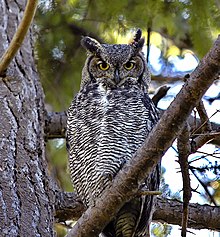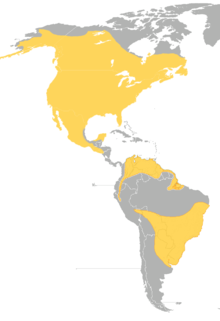Great horned owl
| Great horned owl | |
|---|---|
 |
|
| Common great horned owl B. v. virginianus |
|
 |
|
| Coastal great horned owl, B. v. saturatus Reifel Migratory Bird Sanctuary, Delta, British Columbia, Canada |
|
| Scientific classification | |
| Kingdom: | Animalia |
| Phylum: | Chordata |
| Class: | Aves |
| Order: | Strigiformes |
| Family: | Strigidae |
| Genus: | Bubo |
| Species: | B. virginianus |
| Binomial name | |
|
Bubo virginianus (Gmelin, 1788) |
|
| Subspecies | |
|
About one dozen, see text |
|
 |
|
| Global range (all year) of B. virginianus | |
| Synonyms | |
|
Strix virginiana Gmelin, 1788 |
|
About one dozen, see text
Strix virginiana Gmelin, 1788
and see text
The great horned owl (Bubo virginianus), also known as the tiger owl (originally derived from early naturalists' description as the "winged tiger" or "tiger of the air") or the hoot owl, is a large owl native to the Americas. It is an extremely adaptable bird with a vast range and is the most widely distributed true owl in the Americas. Its primary diet appears to be rabbits and hares, rats and mice and voles, although it freely hunts any animal it can overtake, primarily rodents and other small mammals, but also larger mid-sized mammals, various birds, reptiles, amphibians and invertebrates. In ornithological study, the great horned owl is often compared to the Eurasian eagle-owl (Bubo bubo), a closely related species which, despite the latter's notably larger size, occupies the same ecological niche in Eurasia, and the red-tailed hawk (Buteo jamaicensis), with which it often shares similar habitat, prey and nesting habits by day and is thus something of a diurnal ecological equivalent. The great horned owl is one of the earliest nesting birds in North America, often laying eggs weeks or even months before other raptorial birds.
The great horned owl is generally colored for camouflage. The underparts of the species are usually light with some brown horizontal barring; the upper parts and upper wings are generally a mottled brown usually bearing heavy, complex darker markings. All subspecies are darkly barred to some extent along the sides as well. There is a variable sized white patch on the throat. The white throat may continue as a streak running down the middle of the breast even when the birds are not displaying, which in particularly pale individuals can widen at the belly into a large white area. South American horned owls typically have a smaller white throat patch, often unseen unless actively displaying, and rarely display the white area on the chest. There are individual and regional variations in overall color, with birds from the subarctic showing a washed-out, light-buff color, while those from the Pacific Coast of North America, Central America and much of South America can be a dark brownish color overlaid with blackish blotching. The skin of the feet and legs, though almost entirely obscured by feathers, is black. Even tropical great horned owls have feathered legs and feet. The feathers on the feet of the great horned owl are the second longest known in any owl (after the snowy owl). The bill is dark gunmetal-gray, as are the talons.
...
Wikipedia

